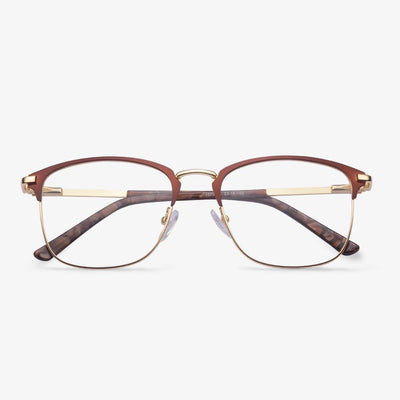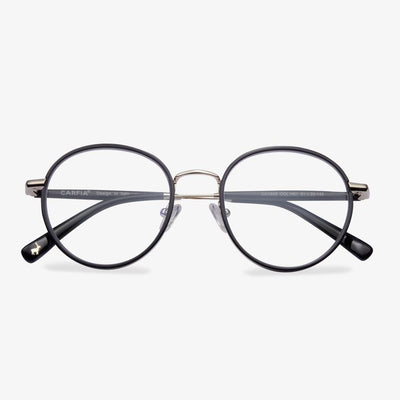Learn the 9 Necessary Parts of Glasses
Rims: the rims lend form and character to your eyeglasses and they also provide function by holding the lenses in place.
End pieces: they are small parts on the frame that extend outward and connect the lenses to the temple.
Bridge: it is the center of the frame that rests on your nose and joins the two rims together.
Hinges: hinges sit between the end pieces and the temple, allowing you to close your glasses folding the temple inward.
Lenses: lenses are the essential parts of eyeglasses. They are clear pieces of glasses, plastic or other lens materials held in place by the rims. The lenses are crafted and shaped with your unique prescription to help you to see clearly.
Screws: they are the small metal fasteners near the hinges and they are used to connect the end pieces with the temples.
Nose pads: nose pads give your glasses a more comfortable and secure fit. They are the round plastic pieces under the bridge that sit on your nose.
Pad arms: pad arms are able to extend from the rims and hold the nose pads in place. They are adjustable to fit the natural shape of your face.
Temples: temples are the long arms on both sides of the frame that fit over your ears for a snug fit.
These are all the 9 essential parts of eyeglasses. Knowing the name of parts of glasses can help you to repair them once they are broken or crooked.
Two Tone Thick Frame Glasses
These two tone chick frame glasses are deliciously composed of two-toned acetate. The stylish oval lens frames feature a semi-transparent tortoiseshell finish melded with a creamy white. A classic keyhole nose bridge, two rivets stud accents, and comfortable spring hinges complete the concept of “wear in comfort, look in style”
Protect the lenses of your safety glasses.
Scratches can be caused by damage at work, aging, improper care, improper cleaning, or improper storage. Whatever the cause of a scratched lens can affect vision quality through the polycarbonate, causing eye strain. Make sure the safety glasses lenses are replaced in time when they are scratched.
How to drive at night with glasses?
Far-light is easy to cause blind spots for drivers of opposite vehicles, and it is possible to cause traffic accidents when driving in the cities. In the process of driving, if the driver encounters the situation that a high beam disrupts the line of sight, can turn the eye in the left or right direction, avoid light sources, and allow your eyes to gradually adapt to the other person's light source. If you can't see clearly, slow down or even pull over.
What is the function of eyeglasses holder straps?
If your glasses are loose or slip off a lot, or if you have an active lifestyle, the eyeglasses holder straps can be very helpful. This simple device is designed to help you track your glasses and keep them from falling off. Retailers sell eyewear holder straps in a variety of designs, materials, and colors.
Should face shape be considered when wearing rimless glasses?
In our life, we will see a lot of people who wear rimless glasses. Compared with full-frame glasses, there is no restriction on face shape and it suits most face shapes. Whether you have a square face, a long face, or a round face, wearing rimless glasses is trendy and beautiful, very popular among contemporary young businessmen and women. Rimless glasses are very easy to wear. No matter what shape your face is, it will feel stylish and beautiful. Rimless glasses are very simple on collocation dresses. And rimless glasses suit most face shapes, so they are suitable for many people.
Wearing glasses correctly will not get deeper degrees
The development of myopia is not directly related to wearing glasses. Patients with myopia wear suitable glasses and pay attention to eye hygiene, and the degree of myopia will stabilize at a certain level. But if you think that with glasses, everything will be fine. If you don't pay attention to eye hygiene in normal times, if you continue to keep your eyes in a state of fatigue for a long time, it will lead to vision loss and deepening of myopia. In addition, wearing improper glasses such as no optometry or inaccurate optometry, too large power, will increase the burden on the eyes, reduce vision and deepen the power. For some people with high myopia (more than 600 degrees), although they insist on wearing glasses, the degree will still deepen, accompanied by changes in the fundus, which is medically called pathological myopia. This deepening of myopia is related to the degree of myopia and family and has nothing to do with wearing glasses.












































